 |
| NEB Class 12 Math Model Question Paper 2079 With Solution |
In This Post, We Provide Complete Class 12 Mathematics [0041] Model Question and Answer Solution 2080 issued by NEB.
Check: SEE Math Model 2080 Solution (with grid)
Class 12 Model Question 2079
Class 12 Mathematics Model Questions 2079/80 With Solution. Latest NEB Model Question & Complete Answer Solution of Math for Class 12 Board Exam 2080. NEB Class 12 Model Question 2079/80 is given as:
Check: Latest Model NEB Class 12 Mathematics Model PDF 2080-2081
Class 12 Model Question Solution 2079
NEB Class 12 Model Question Solution 2079/80 is given as:
Disclaimer:
Answers mentioned here are not solved by teachers. These are the solutions written by a student of Grade 12. If you found some of the solutions mistake please let me know in the comment section below. I took help of book, search engines, and teachers to solve the set. However, the language or process of solving the questions might be informal and in examinations, you might have to add little more language and show more calculations than what has been done here. So, I highly encourage you to view these solutions as guide rather than just copying everything mentioned here.
Candidates
are required to give their answers in their own words as far as
practicable. The figures in the margin indicate full marks.
Time: 3hrs Full Mark:75
Attempt all questions.
Group “A”
1) What is an arrangement of the n natural numbers called?
- A) Induction
- B) Permutation
- C) Combination
- D) Expectation
Ans: B) Permutation
2) Let 1,w,w² be the cube roots of unity. Under which operation is the set A={1,w,w²} closed?
- A) Addition
- B) Subtraction
- C) Multiplication
- D) Division
Ans: C) Multiplication
3) What is the domain of sin^-1x?
- A) x≥1 or x≤-1
- B) (∞,infinity)
- C) -1<x<1
- D) -1≤x≤1
Ans: D) -1≤x≤1
4) ABCD is a parallelogram. Which one of the following represents area of the parallelogram?
- A) Magnitude of vector product of two vectors along AB and BD.
- B) Magnitude of vector product of two vectors along AB and DC.
- C) Magnitude of vector product of two vectors along AC and BC.
- D) Magnitude of vector product of two vectors along AB and AD.
Ans: A) Magnitude of vector product of two vectors along AB and BD.
5) If a conic section has eccentricity(e) = (√a^2-b^2)/a, what is the equation of that conic section?
- A)(x^2/a^2)-(y^2/b^2)=1
- B) (x^2/a^2)+(y^2/b^2)=1
- C) (x^2/a^2)+(y^2/a^2)=1
- D)(x^2/b^2)+(y^2/b^2)=1
Ans: B) (x^2/a^2)+(y^2/b^2)=1
6) If cosӨ =−1/2 for integer (n), what is the general value of Ө ?
- A) 2nπ ±2π/3
- B) nπ + (−1)^n π/3
- C) nπ −π/3
- D) nπ +π/3
Ans: A) 2nπ ±2π/3
7) Let A and B be two dependent events. If P (A) =1/2, P (B) = 3/4 and P(AnB) =2/5, what is the value of P(A/B)?
- A) equal to P(B/A)
- B) equal to P(A)
- C) less than P(A A B)
- D) less than P(B/A)
Ans:D) Less than P(B/A)
8) The edge of a cube increases from 10 cm to 10.025 cm. What would be the approximate increment in volume?
- A) 103 cm^3?
- B) 10.0253 cm^3?
- C) 7.5187 cm^3?
- D) 7.5 cm^3?
Ans: D) 7.5 cm^3?
9) What is the integrating factor of the differential equation cos’× dy + y =1°
- A) tan x
- B) e^tanx
- C) sec^2 x
- D)e^sec1x
Ans: B) e^tanx
10) What is the number of solutions of the system of linear equations × + y = 5 and x + y = 7?
- A) One solution
- B) No solution
- C) Infinite solutions
- D) More than one solution
Ans: B) No solution
11) Forces P and Q are acting along ceiling and floor of a rectangular room. What is the nature of the forces?
- A) Like
- B) unlike
- C) collinear
- D) parallel
Ans: B) unlike
Group “B”
12) For any positive integer n, (a+x)n = C0an
+ C1an-1x + C2an-2x2+……+cnxn.
a) How many terms are there in the expression?
b) Write binomial coefficient in the expansions?
c) Write the general term of the expansion.
d) Write the relations among C (n, r-1), C (n+1, r) and C
(n, r).
e) What is the value of C0+C1+C2
+…+Cn?
Solution:
(a) There will be (n+1) numbers of terms in the
expansion of (a+x)n = C0an + C1an-1x
+ C2an-2x2+……+cnxn.
(b) The binomial coefficient in the expansion of (a+x)n
= C0an + C1an-1x + C2an-2x2+……+cnxn
are: C0, C1an-1, C2an-2,……Cn
(c) The general terms of the expansion is nCran-rxr.
(d) The relations among C (n, r-1), C (n+1, r) and C
(n, r) is nCr + nCr-1 = n+1Cr.
(e) The value of C0+C1+C2 +…+Cn
is 2n.
13) a) Using the principle of mathematical induction,
show that: 1+2+3+…+n < (2n+1)2.
b) Find the quadratic equation whose one of the cube
roots is 2+
Solution:
Step 1: Let n = 1
P(1): 1<[2(1)+1]2 is true.
Hence, the statement is true for n=1
Step 2: Assume that the statement is true for n=k
P (k) : 1 + 2 + 3 + … + k < (2k+1)2
Step 3: Prove that the statement is true
for n=k+1
We need to prove that:
1 + 2 + 3 + …. + (k+1) < [(2k+1)2] + k+1
<
[4k2+4k+1] + 8 ×
× (k+1)
<
[4k2+4k+1+8k+8]
<
[4k2+12k+9]
<
[2k+3]2
<[2(k+1)+1]2
(b) For the quadratic equation if one root (α)= 2
+
Another Root (β) = 2 –
Sum of Roots (α+ β) = 2 – + 2 + =4
Products of Roots (α × β) = (2 – )(2 + )
= 1
∴Quadratic equation : x2 -(α+ β)x
+ (α
× β) =0
∴ x2−4x+1=0 is required equations.
14) a) Given y = sin-1x and y>0, express
cos y and tan y in terms of x.
b) If , , and are any three vectors such that × = × for ≠(0,0).
Show that: = .
Solution:
(a) Given:
y = sin-1x
or, x = sin y
We have, Cos2y + Sin2y = 1
Or, Cos2y=1- Sin2y
Or, Cos2y = 1-x2
Thus, Cos y =
And,
(b) Given:
× = ×
If Cross product is equal then their magnitude is also
equal.
| × | = | × |
Or, ||
|| Sinθ = | | || Sinθ
Or, | |=| |
∴ =
15) The price in Rupees (X) and demand in unit (Y) of 6
days of a week is given as:
X | 10 | 12 | 13 | 12 | 16 | 15 |
Y | 40 | 38 | 43 | 45 | 37 | 43 |
Calculate the Pearson’s Coefficient of Correlation and
the regression coefficients of X on Y.
Solution:
x | y | xy | x2 | y2 |
10 | 40 | 400 | 100 | 1600 |
12 | 38 | 456 | 144 | 1444 |
13 | 43 | 559 | 169 | 1849 |
12 | 45 | 540 | 144 | 2025 |
16 | 37 | 592 | 256 | 1369 |
15 | 43 | 645 | 225 | 1849 |
Σx=78 | Σy=246 | Σxy=3192 | Σx2=1038 | Σy2=10136 |
Value of n = 6
Now, Regression Coefficient of x on
y is
16) a) Define Hospital’s rule.
b) Write the slope of the tangent and normal to the curve
y =f(x) at (x1,y1).
c) Write the integral of .
d)What is the integral of
Solution:
(a) If f(x) and g(s) are two function then their
derivatives f’(x) and g’(x) are continuous at x=0 and if f(a) =g(a), then,
When g’(a)≠0.
(b) The slope of tangant to the curve y=f(x) at (x1,y1)
is
Then, Slope of normal to y=f(x) at ((x1,y1)) is
F’(x). m = -1
Thus, m=
(c) =
(d) = coshx +C
17) a) Solve:
b) Verify Rolle’s Theorem for f(x) = x2+3x-4
in [-4,1].
Solution:
Integrating both sides:
ln(y) = ln(x) +C
or, ln(y) = ln(x) + ln(C)
Thus, y=xc
(b) f(x) = x2+3x-4 in [-4,1]
(i) Here f(x) is a polynomial function so it is continuous at
[-4,1].
(ii) f’(x) = 2x+3
f(x) is differentiable in (-4, 1).
(iii) f(-4) = 0, f(1) = 0
Thus, f(a) = f(b).
All the condition of Rolle’s Theorem are verified. So there
exists at least a point C ε (-4, 1).
Such that: f’(C) =0.
18) Using simplex method, maximize P
(x, y) = 15x+10y subject to 2x+y≤10, x+3y≤10, x, y≥0.
Solution:
Maximize P (x, y) = 15x+10y
Subject to:
2x+y≤10
x+3y≤10
x, y≥0
Let S1 and S2 be two non-negative
slack variables. Then, the standard form of the above LPP is:
2x+y+r =10
x+3y+s=10
-15x-10y+P=0
The initial simplex tableau for above LLP is
Basic Variable | x | y | r | s | p | Constant |
r | 2 | 1 | 1 | 0 | 0 | 10 |
s | 1 | 3 | 0 | 1 | 0 | 10 |
-15 | -10 | 0 | 0 | 1 | 0 |
In the initial Simplex tableau the most negative entry is
-15 so the x-column is pivot column. Also, =5 is the smallest positive
value. Thus, r-row with element 2 on x column is the pivot element.
Dividing First Row by 2
Basic Variable | x | y | r | s | p | Constant |
r | 1 | ½ | ½ | 0 | 0 | 5 |
s | 1 | 3 | 0 | 1 | 0 | 10 |
-15 | -10 | 0 | 0 | 1 | 0 |
R2à
R2-R1 and R3à R3+15R1
Basic Variable | x | y | r | s | p | Constant |
r | 1 | ½ | ½ | 0 | 0 | 5 |
s | 0 |
| -½ | 1 | 0 | 5 |
0 | – | 0 | 1 | 75 |
Here last row still has -ve entry. So y is pivot column and
s-row is the pivot row with as pvot element.
R2à
R2
Basic Variable | x | y | r | s | p | Constant |
r | 1 | ½ | ½ | 0 | 0 | 5 |
s | 0 | 1 | – | 0 | 2 | |
0 | – | 0 | 1 | 75 |
Again, R3 à
R3+R2 and R1àR1– ½ R2
Basic Variable | x | y | r | s | p | Constant |
r | 1 | ½ |
| – | 0 | 4 |
s | 0 | 1 | – | 0 | 2 | |
0 | 0 | 7 | 1 | 1 | 80 |
Since there is no negative entry in last row. Thus Maximum
Solution is obtained.
Pmax=80 at x=4 and y=2.
19) A particle is projected with a velocity ‘v’ and
greatest height is ‘H’, prove the horizontal range R is: R = 4.
Solution:
Let β be angle of projection. Then,
Now,
=
=
=
And,
R.H.S of Question:
4 =
=R
=L.H.S
OR
The cost function C(x) in thousands of rupees for
producing x units of math’s textbooks is given by C(x)=30+20x-0.5x2
, 0≤x≤15.
a) Find the marginal cost of Function.
b) Find the marginal cost for producing 12000 math’s
textbooks.
Solution:
C(x)=30+20x-0.5x2, x, y≥0
(a) Marginal Cost of Function = C‘(x)=0+20-x
(b) Marginal cost = 20-x=20-12=Rs. 8 (in thousands)
Group “C”
20) a) Using matrix methods, solve the following system of
linear equations: x+y+z = 4, 2x+y-3z = -9,2x-y+z = -1
b) Apply De-Moiver’s theorem to find the value of [2(𝑐𝑜𝑠15°
+ 𝑖𝑠𝑖𝑛15°)] 6
c) Prove that:
Solution:
(a)
(b) De Moiver’s Theorem states that, {r(cosθ+isinθ)}n=rn(cosnθ+isinnθ).
∴[2(𝑐𝑜𝑠15° + 𝑖𝑠𝑖𝑛15°)]
6 = 26 [cos90 + i sin90] = 64i
(c) We Know ex=
Put x = 1
e1=(i)
Put x = -1
e-1=(ii)
Taking LHS of Question:
=e × e–
=1
=R.H.S
21) a) Find the direction cosines of the line joining the
points (4,4,-10) and (-2,2,4).
b) Find the angle between the two diagonals of a cube.
c) Find the vertices of the conic section: 16(y-1)2
-9(x-5)2 = 144.
Solution:
(a) Given Points: P(4,4,-10) and Q(-2,2,4)
Direction ratios of PQ = -2-4, 2-4, 4-(-10)=-6, -2, 14
PQ=
Thus, Direction cosines are:
(b) Let OABCDEFG be a cube with vertices as
below
O(0,0,0),A(a,0,0),B(a,a,0),C(0,a,0),D(0,a,a),E(0,0,a),F(a,0,a),G(a,a,a)
There are four diagonals OG,CF,AD and BE for
the cube.
Let us consider any two say OG and AD
We know that if A(x1,y1,z1) and B(x2,y2,z2) are
two points in space then
AB=(x2−x1)i+(y2−y1)j+(z2−z1)k
⇒OG=(a−0)i+(a−0)j+(a−0)k=ai+aj+ak
and AD=(0−a)i+(a−0)j+(a−0)k=−ai+aj+ak.
Therefore ∣∣=
And,
=
We know that angle between two vectors is given by θ =
=
=
Thus, angle between two vectors is
(c) Given:
16(y-1)2 -9(x-5)2 = 144….(i)
Dividing Both Sides by 144.
Comparing with
We Get:
h=1, k=5, a=3, b=4
Thus, Vertex = (h±a, k) = (1±3, 4) =(4,4) 0r (-2, 4)
22) a) If the limiting value of at x= 3 is 2 by using L’ Hospital’ rule, find the appropriate value of
f(x).
b) Write any one homogeneous differential equation in
(x,y) and solve it.
c) The concept of anti-derivative is necessary for
solving a differential equation. Justify this statement with example.
Solution:
(a)
(b) Homogenous
differential Equation in (x,y) is
Solving This Equation:
Put y =vx, then
Integrate both sides
v = log x + log c
or, v = log cx
Replacing v
∴ y = x log cx
(c) The concept of anti-derivatives is necessary for
solving differential equation. Let’s understand this statement through the following
example:
Consider a differential Equation
i.e., y.dy = x.dx
Let’s integrate this on both sides:
Or, y2=x2+2C
i.e., y2=x2+C
Math Model Question Solution Youtube Video
The below answer provided for question 15 is incorrect. you can check correct answer from above but
ans –0.12 aau xa.
Group “C”
Download Math Model Question Solution
Download


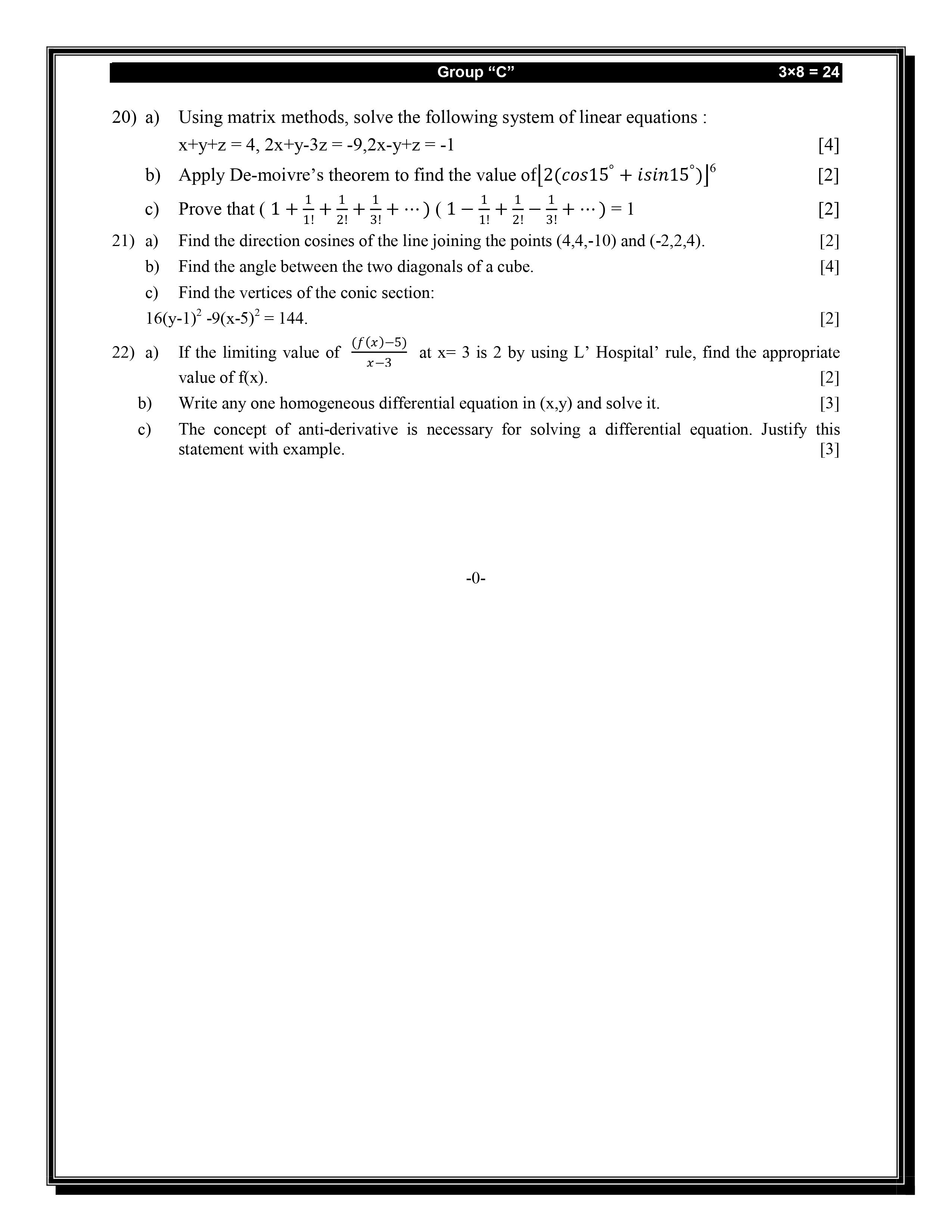
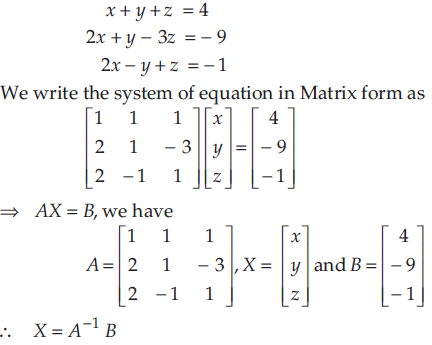
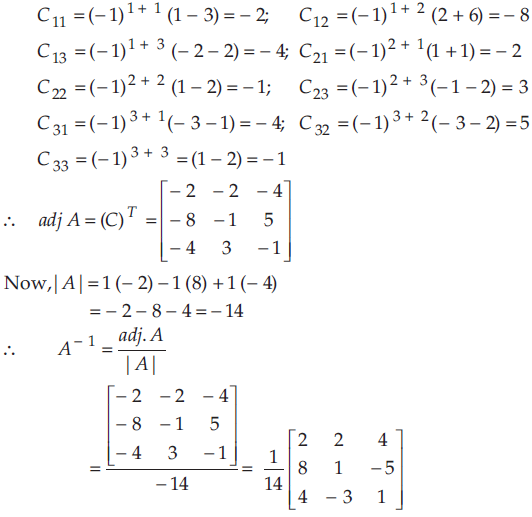
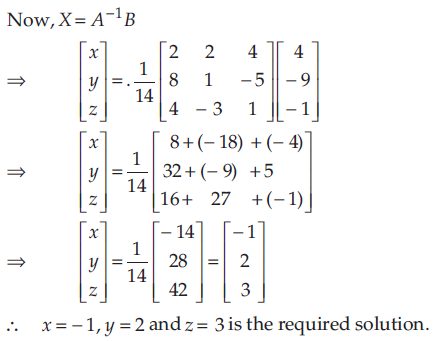


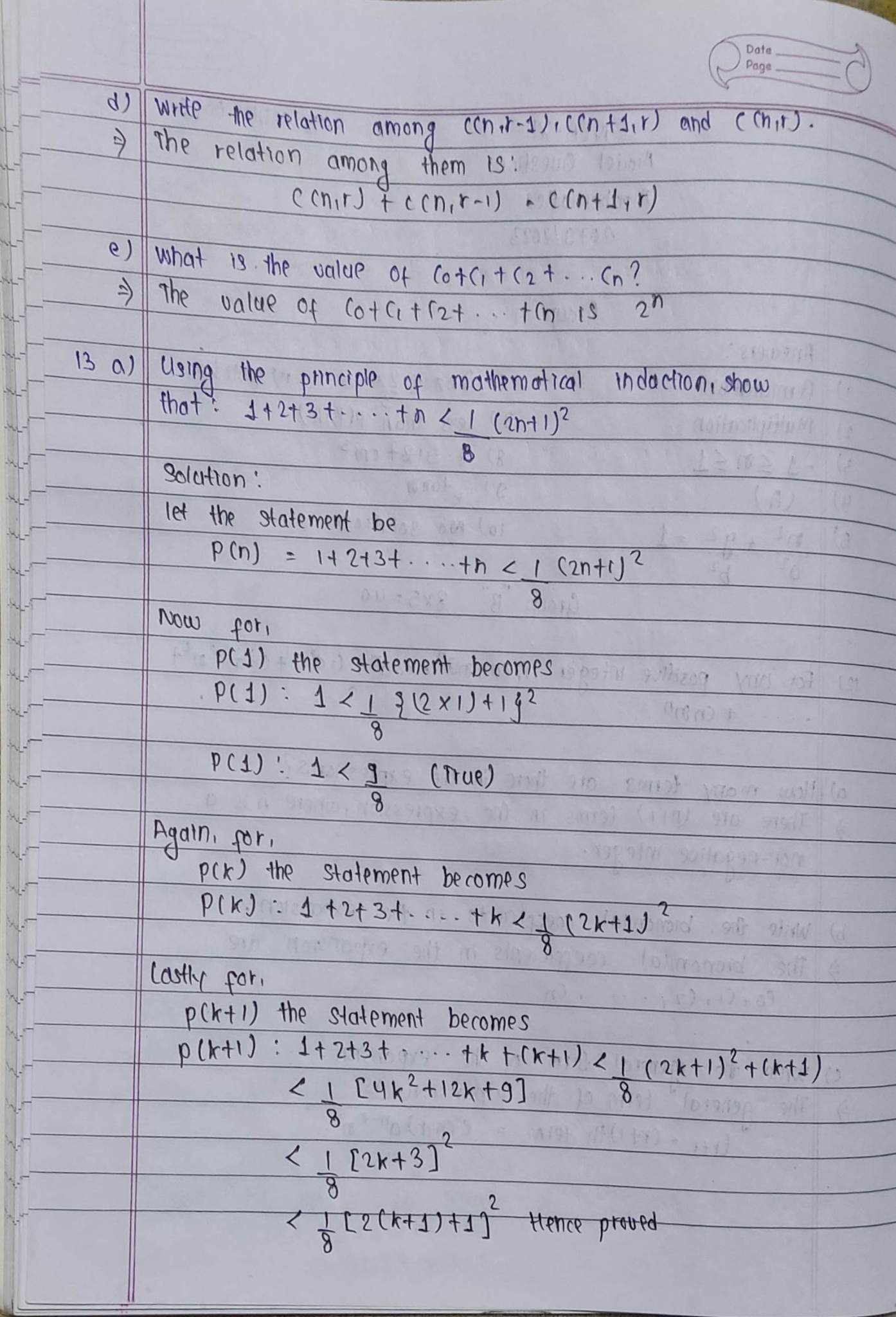

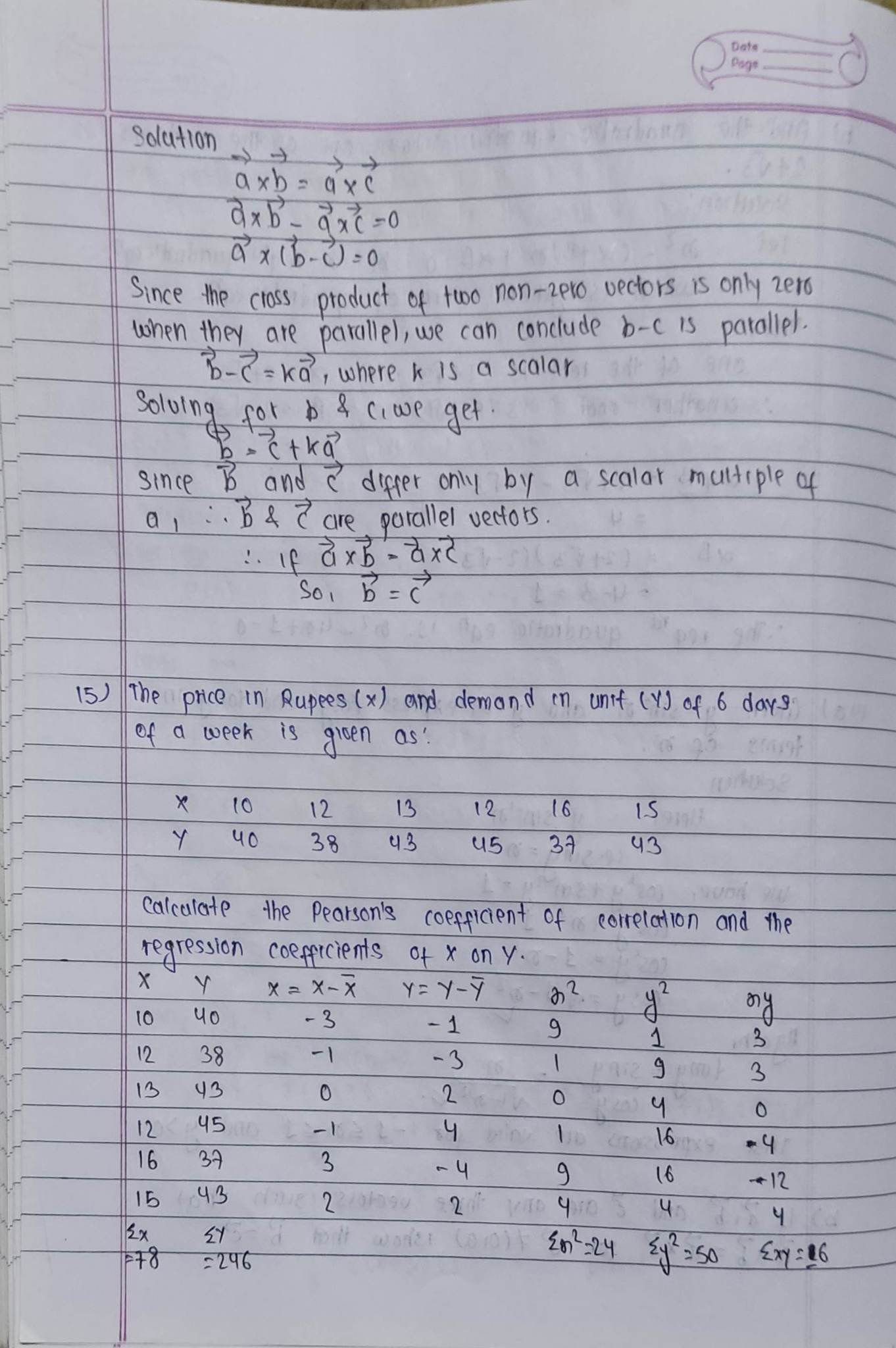
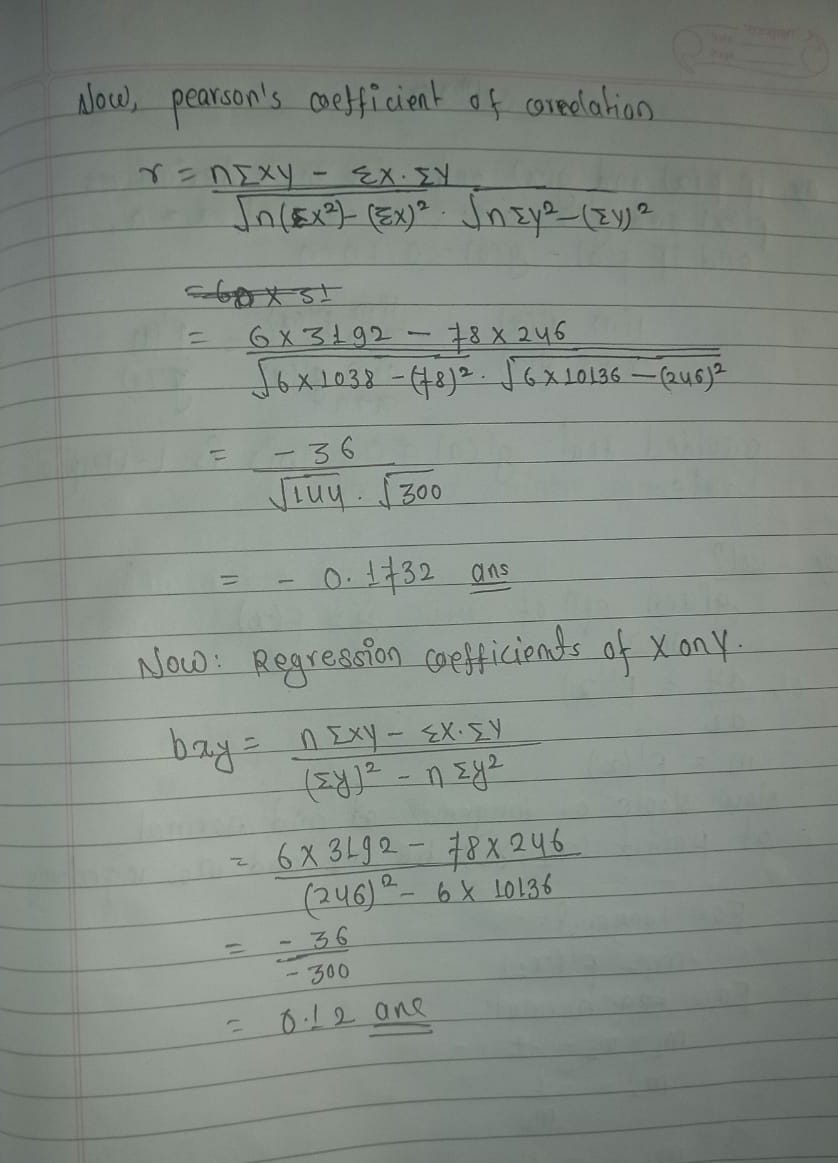
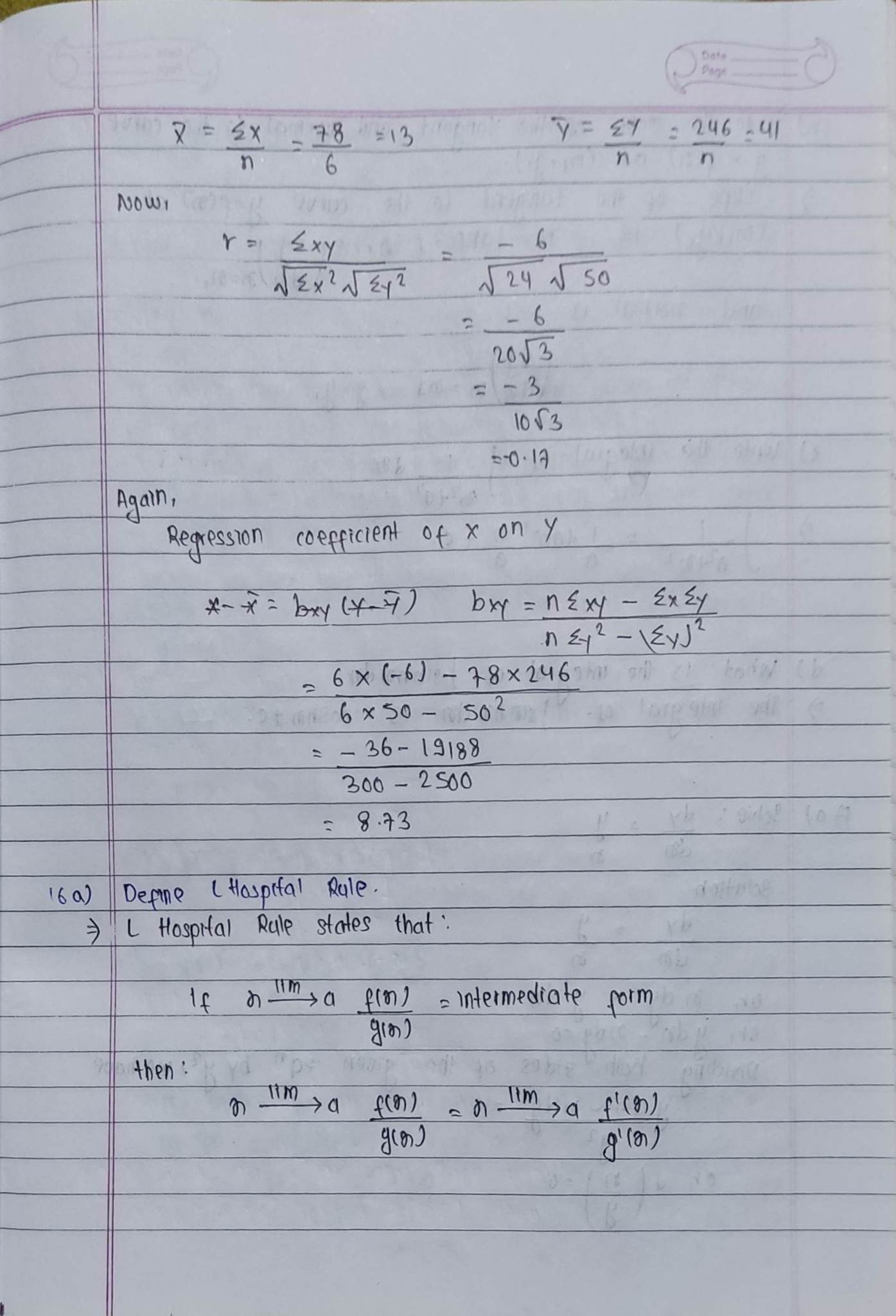


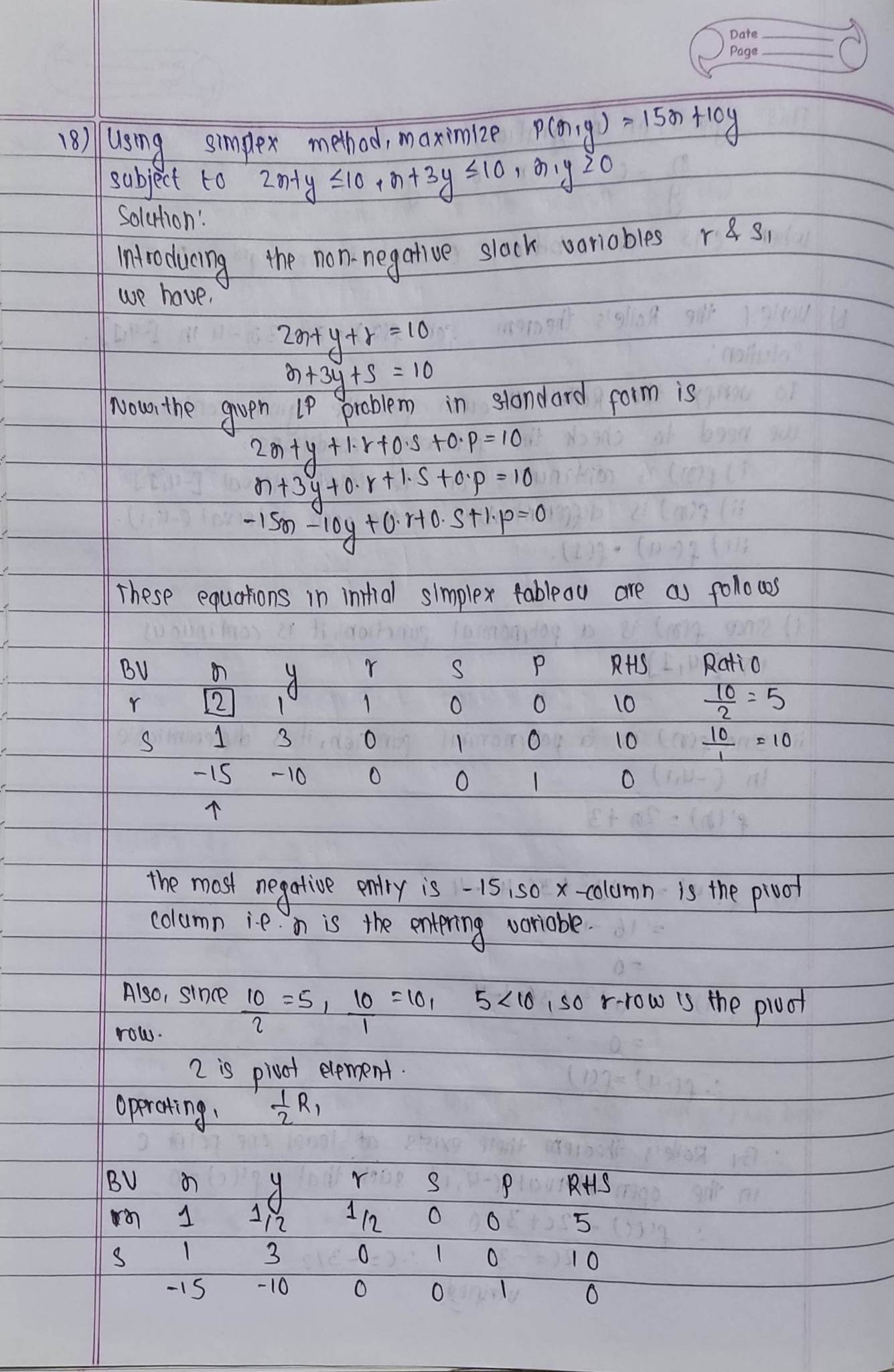

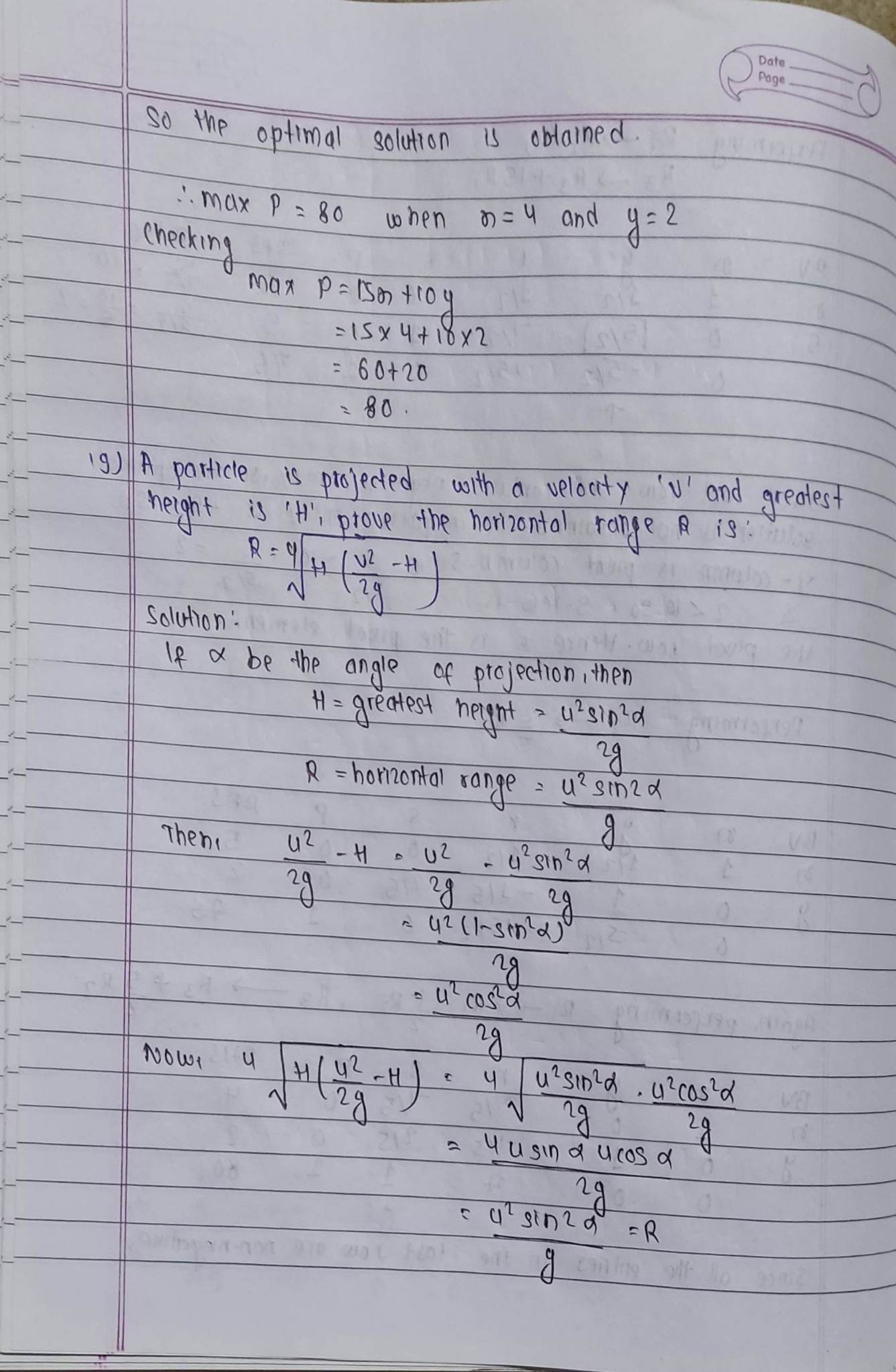
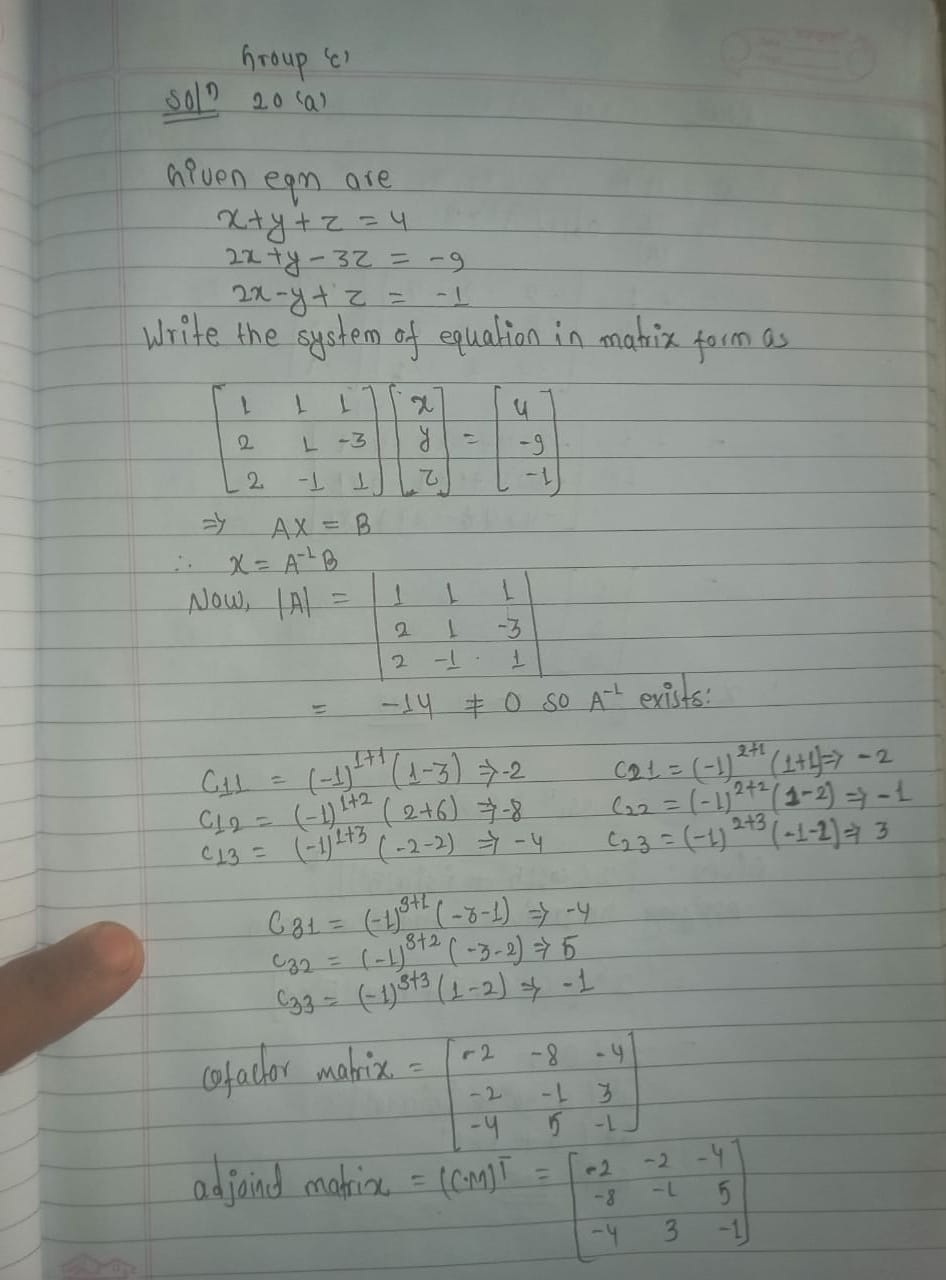
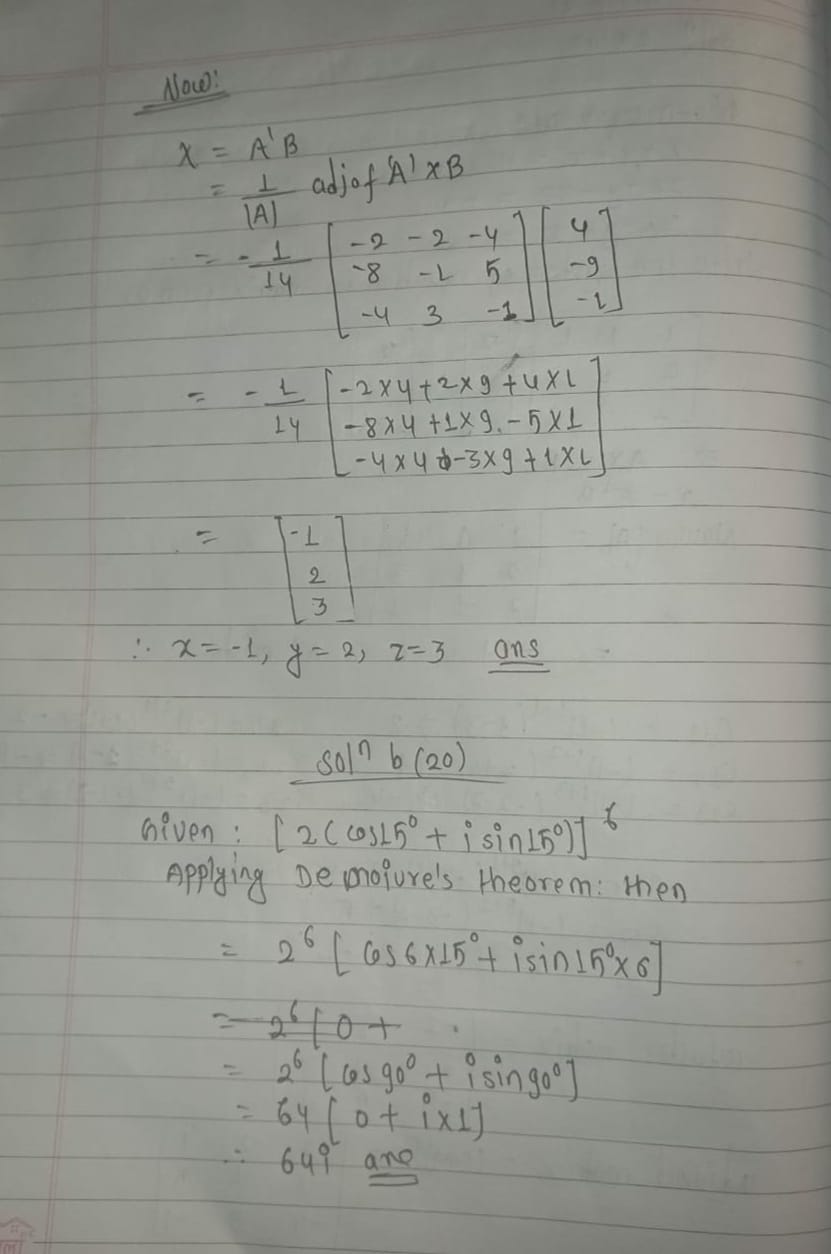



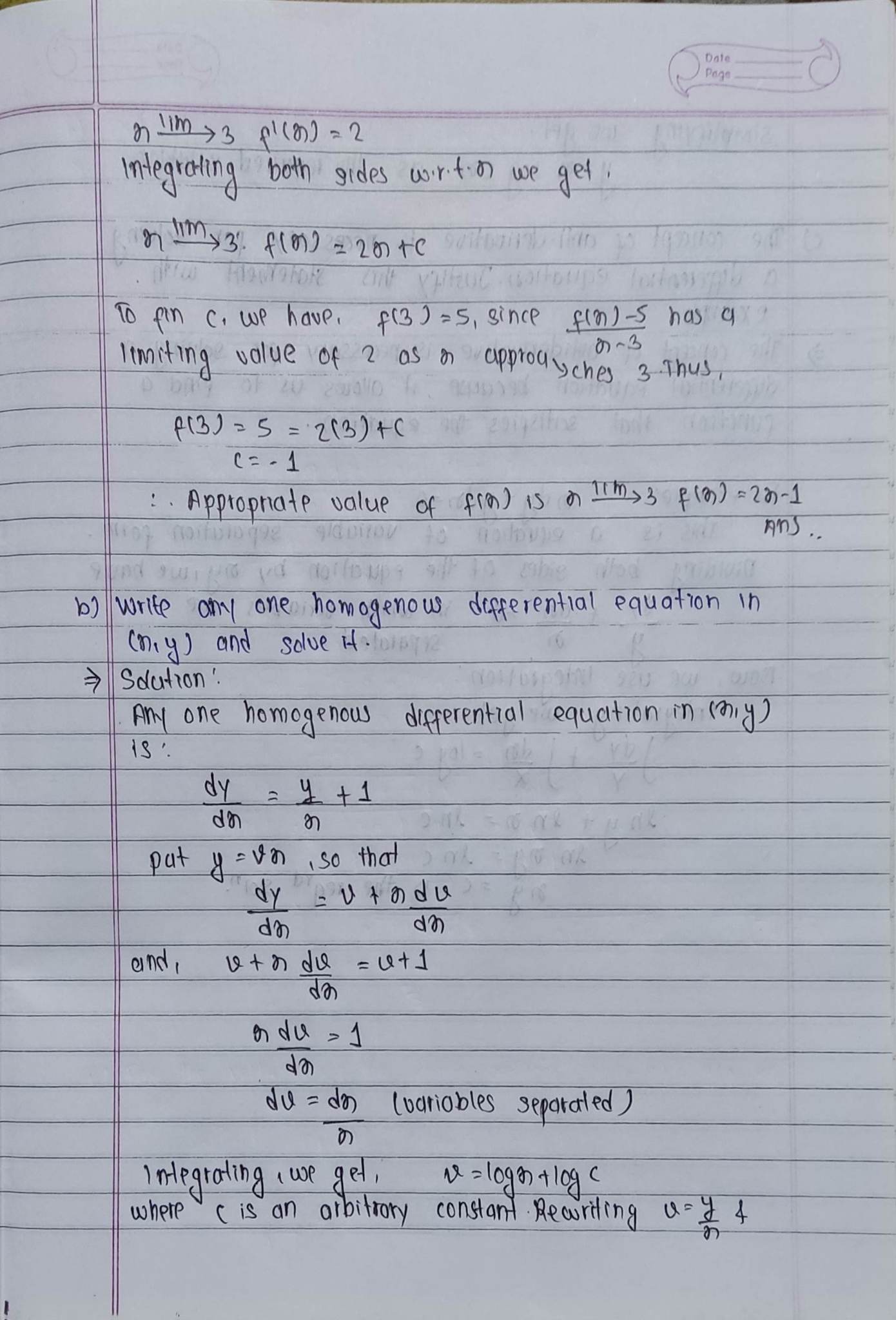

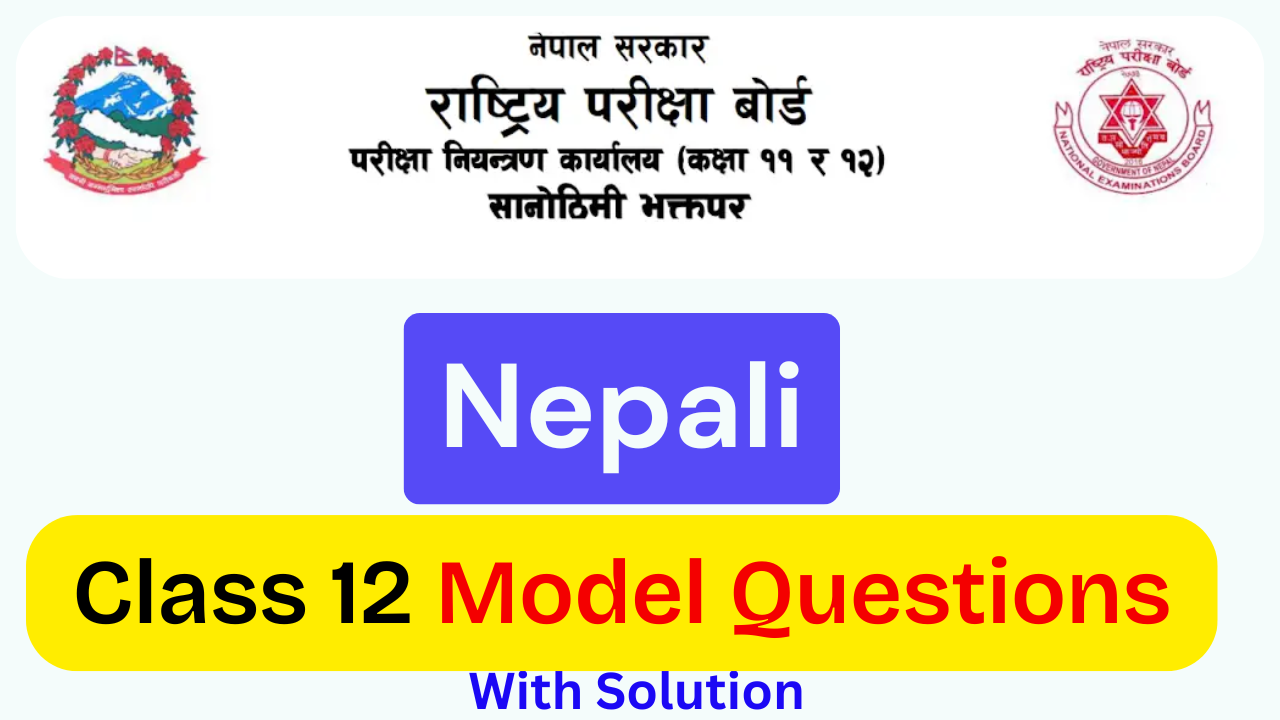
aaba hernuhos ta answer melya xa ke nai
yes yes; wrong xa jasto xa; thankyou;
Can you please, check question number 15 (last part ) I think that one is incorrect.
How can I contact you? Mam/sir
The correct answer is A) Magnitude of vector product of two vectors along AB and BD.
To see why, let's recall that the area of a parallelogram can be calculated as the magnitude of the cross product of two adjacent sides. In this case, we can choose AB and AD as the adjacent sides, and calculate the cross product of the vectors along these sides:
Area = |AB x AD|
However, we can also express AD as the sum of AB and BD (since AB and AD are adjacent sides of the parallelogram), giving us:
AD = AB + BD
Substituting this into the expression for the cross product, we get:
Area = |AB x (AB + BD)|
Expanding the cross product using the distributive property, we get:
Area = |AB x AB + AB x BD|
Since the cross product of a vector with itself is zero (i.e., v x v = 0 for any vector v), we can simplify this to:
Area = |AB x BD|
Therefore, the area of the parallelogram can be calculated as the magnitude of the vector product of two vectors along AB and BD, which is option A.
Mcq no.4 ko answer d hunxa hola
if one root is 2 +√3 then another will be 2-√3 ; We can then use the fact that complex roots of a quadratic equation come in conjugate pairs to find the other root
tyo 13 ko b ma another root 2-√3 kina lekheko? question le kei clarify nei gareko xaina arko root yesto hunxa vanera, eetikai ans milauna lai testo lekhna painxa ra?